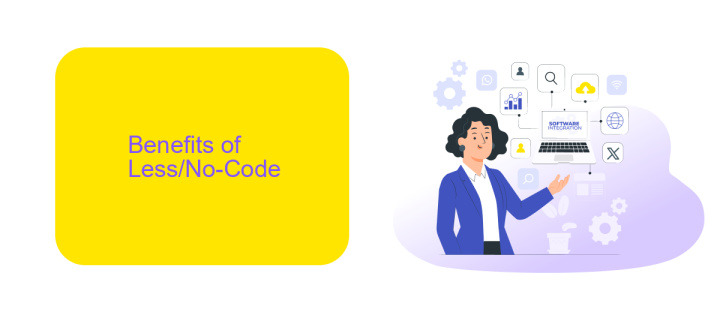Less Code No-Code
In today's rapidly evolving tech landscape, the demand for quicker and more efficient software development solutions is higher than ever. Less Code and No-Code platforms are revolutionizing the way businesses and individuals create applications, enabling even those without extensive programming knowledge to develop robust and scalable solutions. This article explores the benefits, challenges, and future prospects of these innovative development paradigms.
Less Code/No-Code Overview
Less Code/No-Code platforms are revolutionizing the way businesses approach software development. By enabling users to create applications with minimal or no coding skills, these tools significantly reduce development time and costs. They empower non-technical users to build functional and customized applications, thereby democratizing the development process.
- Reduced development time and costs
- Empowerment of non-technical users
- Enhanced flexibility and customization
- Streamlined workflows and integrations
One of the standout features of Less Code/No-Code platforms is their ability to integrate various services seamlessly. For instance, ApiX-Drive offers a robust solution for setting up integrations without any coding. This service allows users to connect different applications and automate workflows effortlessly, enhancing productivity and operational efficiency. As a result, businesses can focus more on innovation and less on the technical complexities of application development.
Benefits of Less/No-Code

Less and no-code platforms offer significant advantages, particularly for businesses looking to streamline their development processes. One of the main benefits is the reduction in time and cost associated with software development. By enabling non-technical users to create applications and automate workflows, these platforms democratize development and reduce the dependency on specialized IT staff. This accelerates project timelines and allows for quicker iterations and deployments, ultimately leading to faster time-to-market for new products and features.
Another key advantage is the ease of integration with other tools and services. For instance, platforms like ApiX-Drive facilitate seamless integration between various applications, making it easier to automate complex workflows without the need for extensive coding. This not only enhances operational efficiency but also ensures that disparate systems can communicate effectively, leading to more cohesive and streamlined business processes. Overall, less and no-code solutions empower organizations to innovate rapidly while maintaining flexibility and scalability.
Challenges of Less/No-Code

Despite the growing popularity of Less/No-Code platforms, there are several challenges that users may encounter. These challenges can impact the efficiency and effectiveness of these tools, especially for complex projects.
- Limited Customization: Less/No-Code platforms may not offer the same level of customization as traditional coding. Users might find it difficult to implement specific features or functionalities.
- Scalability Issues: As projects grow, the limitations of these platforms can become more apparent. They might struggle to handle large-scale applications or complex workflows.
- Integration Challenges: Integrating with other systems and services can be cumbersome. Although tools like ApiX-Drive help streamline integrations, there can still be compatibility issues.
- Performance Concerns: Applications built on Less/No-Code platforms may not perform as efficiently as those developed with traditional coding, particularly under heavy loads.
- Dependency on Platform: Users become dependent on the platform's ecosystem, which can be risky if the platform changes its policies or discontinues services.
While Less/No-Code platforms offer many benefits, it is crucial to be aware of these challenges. Understanding these limitations can help users make informed decisions and choose the right tools for their specific needs.
Best Practices for Less/No-Code

Implementing best practices in less/no-code development can significantly enhance your project's efficiency and maintainability. Start by thoroughly understanding the capabilities and limitations of your chosen platform. This ensures you select the right tool for your specific needs and avoid potential pitfalls.
Careful planning is crucial. Outline your workflow and identify key components before diving into development. This approach helps in minimizing errors and streamlining the process. Additionally, consider the long-term scalability of your solution to accommodate future growth.
- Test thoroughly to ensure all components function as expected.
- Regularly update and maintain your no-code solutions to keep them secure and efficient.
- Leverage integrations, like ApiX-Drive, to connect various services seamlessly.
- Document your processes and configurations for future reference and troubleshooting.
By following these best practices, you can maximize the benefits of less/no-code development. This approach not only speeds up deployment but also ensures a robust and adaptable solution. Remember, the goal is to create efficient, scalable, and maintainable applications with minimal coding effort.
Use Cases for Less/No-Code
Less and no-code platforms are revolutionizing the way businesses approach software development by enabling non-technical users to create applications, automate workflows, and streamline processes. One of the primary use cases is in small to medium-sized enterprises (SMEs) that need to develop custom solutions quickly and cost-effectively. These platforms allow business owners and managers to build and deploy applications without relying on expensive development teams, thereby reducing operational costs and accelerating time-to-market.
Another significant use case is in the realm of integrations. Tools like ApiX-Drive facilitate seamless data transfer between various applications, making it easier to create automated workflows without writing a single line of code. For instance, marketing teams can integrate their email marketing software with customer relationship management (CRM) tools to synchronize data effortlessly. This ensures that all customer information is up-to-date across platforms, enhancing efficiency and reducing the likelihood of errors. Overall, less and no-code solutions empower businesses to innovate and adapt quickly in a fast-paced digital landscape.
FAQ
What is Low-Code/No-Code development?
What are the benefits of using Low-Code/No-Code platforms?
Can Low-Code/No-Code platforms handle complex integrations?
Are Low-Code/No-Code platforms secure?
Who can benefit from Low-Code/No-Code development?
Apix-Drive will help optimize business processes, save you from a lot of routine tasks and unnecessary costs for automation, attracting additional specialists. Try setting up a free test connection with ApiX-Drive and see for yourself. Now you have to think about where to invest the freed time and money!

